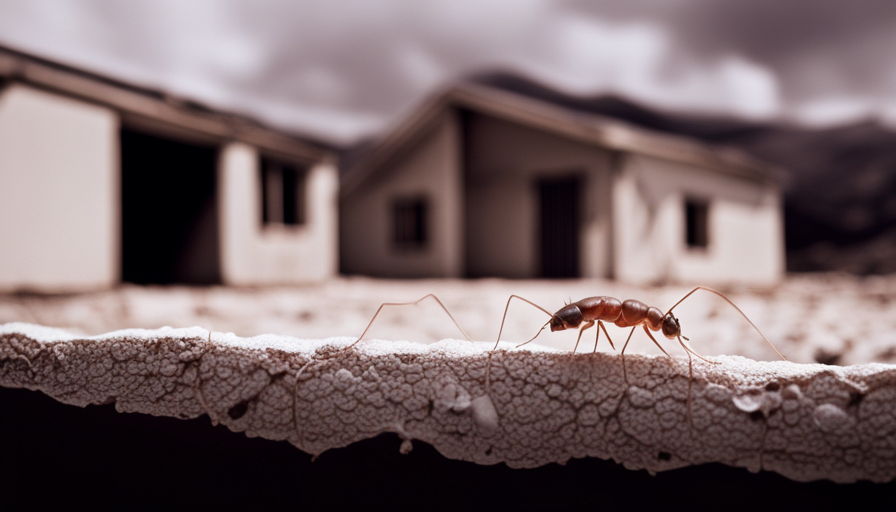Have you ever experienced a invasion of tiny ants entering your home and infiltrating your beloved walls? It’s like an unwelcome army taking control of your private space. But fear not, as I have the ultimate guide to prevent these pesky pests from causing havoc in your home.
In this article, I will share my personal experience and provide you with practical tips on how to keep those tiny little ants at bay.
From identifying the ant species to sealing entry points, using natural repellents to setting up ant baits, and even trimming outdoor vegetation, I’ve got you covered.
But it doesn’t stop there! I will also teach you how to keep your home clean, seal trash properly, and regularly maintain and inspect your home to ensure those tiny little ants stay far away.
And if all else fails, don’t hesitate to call in the professionals.
So, let’s roll up our sleeves and get ready to kick those tiny little ants out of our house walls once and for all!
Key Takeaways
- Identifying the ant species is crucial for developing an effective plan to keep them out of house walls.
- Sealing entry points by caulking gaps, cracks, and crevices prevents ants from entering.
- Using natural repellents like vinegar, water, and citrus peels can deter ants from infiltrating the home.
- Setting up ant baits can eliminate ants and prevent future infestations by targeting the entire colony.
Identify the Ant Species
So, let’s figure out what kind of ants we’re dealing with, shall we? Identifying the species is crucial in developing an effective plan to keep those pesky little creatures out of our house walls.
One common place to find ants is in the garden, so start by observing their behavior there. Look for trails of ants, especially near plants or food sources. Take note of their size, color, and any distinctive features. Once you have identified the ant species, you can research specific ant control methods that work best for that particular type.
For example, if you discover that you’re dealing with carpenter ants, it’s important to know that they typically nest in damp or decaying wood. In this case, it’s crucial to locate and eliminate any moisture problems in your home, as well as remove any damaged or rotting wood. Additionally, sealing entry points into your house will prevent ants from finding their way inside. By caulking gaps, cracks, and crevices around windows, doors, and utility pipes, you create a barrier that ants cannot penetrate.
By identifying the ant species and implementing appropriate control methods, we can effectively prevent those tiny little ants from infiltrating our house walls.
Seal Entry Points
To keep those pesky critters out, make sure you’re sealing up any possible entry points in your home. Preventive measures are key when it comes to keeping tiny little ants from invading your space. These insects can squeeze through even the tiniest of cracks, so it’s important to be thorough in your efforts.
Start by inspecting the exterior of your home for any gaps or openings. Pay close attention to areas where pipes or wires enter the house, as these are common entry points for ants. Use caulk or weatherstripping to seal up any gaps you find. Don’t forget to check windows and doors for any gaps as well.
In addition to sealing entry points, there are also some DIY solutions you can try. Sprinkling cinnamon or peppermint around entry points is said to deter ants, as they dislike the smell. You can also create a homemade ant repellent by mixing equal parts vinegar and water, then spraying it around the areas where ants are entering. These methods may not work for every situation, but they’re worth a try.
Now that you’ve taken steps to seal up your home, it’s important to keep a clean home to further prevent ants. By eliminating potential food sources and maintaining a tidy environment, you can greatly reduce the chances of an ant infestation.
Keep a Clean Home
Maintaining a tidy living space is crucial in deterring unwanted ant visitors and ensuring a pest-free environment. One important aspect of a clean home is proper ventilation. Good airflow helps in keeping the humidity levels low, which is essential for preventing ant infestations.
Ants are attracted to moisture, and high humidity creates the perfect environment for them to thrive. By opening windows, using fans, and allowing fresh air to circulate, you can reduce the moisture content inside your home and make it less appealing to ants.
It’s important to note that excessive humidity can lead to mold and mildew growth, which can also attract ants. Regularly check for and fix any leaks or water damage in your home to prevent these issues. Additionally, ensure that your bathroom and kitchen are well-ventilated by using exhaust fans or opening windows when necessary.
By maintaining proper ventilation and keeping humidity levels in check, you can significantly reduce the likelihood of ant infestations in your home.
In the next section, we will explore the use of natural repellents to further enhance your ant prevention strategy.
Use Natural Repellents
Try using natural repellents to keep ants away and make your home a less attractive place for them. Natural remedies are a safe and effective way to deter ants from entering your house. Not only are they environmentally friendly, but they can also be easily made with ingredients commonly found in your kitchen. Homemade ant repellents are a great alternative to chemical-based products, especially if you have children or pets.
One effective natural repellent is a mixture of vinegar and water. Ants dislike the strong smell of vinegar, so spraying this solution around entry points and along ant trails can help deter them. Another option is to use citrus peels, such as lemon or orange. The strong scent of these fruits acts as a natural deterrent for ants. Simply place the peels near areas where ants are commonly found.
To provide a visual representation of these natural repellents, here is a table showcasing their effectiveness:
| Natural Repellents | Effectiveness |
|---|---|
| Vinegar and water | High |
| Citrus peels | Medium |
Using these natural repellents can be a good first step in preventing ants from invading your home. In the next section, we will discuss how to set up ant baits to further eliminate these pesky insects.
Set Up Ant Baits
Setting up ant baits is a strategic way to lure and eliminate those pesky insects from your home. Not only are ant baits effective in getting rid of ants, but they also serve as preventive measures to avoid future ant infestations. Here are four reasons why ant baits are a great solution:
-
Targeted Approach: Ant baits are designed to attract ants with a tempting bait that they carry back to their nest. This ensures that the entire ant colony is affected, including the queen, leading to long-term elimination.
-
Low Maintenance: Once you set up ant baits, they require minimal effort on your part. Simply place them in areas where ants are commonly seen, and let them do their job. It’s a hassle-free way to deal with ant infestations.
-
Safe for Indoor Use: Ant baits are typically formulated with low toxicity, making them safe to use indoors. You don’t have to worry about harmful chemicals affecting your family or pets.
-
Long-lasting Effects: Ant baits provide a lasting solution by targeting the root cause of the infestation. By eliminating the entire colony, you reduce the chances of future ant problems.
By setting up ant baits, you can effectively tackle the ant problem in your home. However, if you’re looking for another effective method, try diatomaceous earth.
Try Diatomaceous Earth
Using diatomaceous earth is a powerful and efficient way to eradicate ants and protect your home from future infestations. This natural and effective ant control method consists of using a fine powder made from the fossilized remains of tiny aquatic organisms called diatoms. When ants come into contact with diatomaceous earth, it damages their exoskeleton, causing them to dehydrate and die.
To better understand the benefits of using diatomaceous earth for ant control, let’s take a look at the following table:
| Pros | Cons | Tips | Precautions |
|---|---|---|---|
| Safe for pets | Requires reapplication | Apply in dry conditions | Avoid inhalation and eye contact |
| Non-toxic to humans | May not kill all ants | Use a duster or brush to apply | Keep away from food preparation |
| Environmentally friendly | Can be messy | Focus on entry points | Store in a dry and cool place |
| Long-lasting effect | Not effective on wet surfaces | Repeat application as needed | Keep out of reach of children |
Using diatomaceous earth provides a natural and effective solution for ant prevention. This method is safe for both pets and humans, making it an ideal choice for households with children and animals. While it may require reapplication and can be a bit messy, the long-lasting effect and environmentally friendly nature of diatomaceous earth make it a practical choice for dealing with ant infestations.
Now that you’ve learned about using diatomaceous earth, let’s explore another alternative method for ant prevention: trimming outdoor vegetation.
Trim Outdoor Vegetation
Take a walk outside through your lush garden and notice how the overgrown bushes and plants provide the perfect hiding spots for those pesky ants. To prevent them from infiltrating your home, it’s essential to prune overgrown plants regularly.
By trimming back the vegetation, you eliminate potential pathways for the ants to access your house. Make sure to remove any branches or leaves that touch the exterior walls, as these can serve as bridges for the tiny invaders.
In addition to pruning, consider installing ant deterrents around the perimeter of your garden. There are various options available, such as ant traps or natural repellents, that can discourage ants from venturing too close to your house. These deterrents work by emitting scents that ants find unpleasant or by using non-toxic substances that disrupt their communication and foraging patterns.
By taking these proactive measures, you can significantly reduce the likelihood of ants making their way into your home. However, it’s important to note that prevention is an ongoing process, and regular maintenance is necessary to ensure long-term success.
So, now that you’ve tackled the outdoor vegetation, let’s move on to the next step of keeping trash sealed to further fortify your defenses against these persistent pests.
Keep Trash Sealed
To effectively keep ants at bay, it’s crucial to ensure your trash is tightly sealed. Proper trash disposal is one of the key ant-proofing techniques that can help prevent these tiny pests from infiltrating your home. When it comes to dealing with ants, attention to detail is essential.
To illustrate the importance of keeping trash sealed, let’s take a look at the table below:
| Trash Disposal Mistakes | Consequences |
|---|---|
| Leaving trash bags open | Invites ants to feast on leftovers |
| Using unsealed bins | Allows ants easy access |
| Neglecting to clean trash cans | Creates a lingering food source |
By sealing your trash tightly, you deny ants the opportunity to find a food source and establish a colony near your home. It’s important to dispose of trash regularly and ensure that bins are properly closed. Additionally, cleaning your trash cans regularly can eliminate any traces of food that might attract ants.
By implementing these simple ant-proofing techniques, you can significantly reduce the chances of ants invading your home. However, if the ant problem persists despite your efforts, it may be time to seek professional help. Professional pest control services have the expertise and tools to effectively address ant infestations.
Call Professional Help
If you’re experiencing persistent ant infestations despite your efforts, it may be time to seek professional help. Studies have shown that 90% of homeowners who enlist the assistance of pest control services successfully eliminate ant colonies.
Here are three reasons why hiring a professional can be beneficial:
-
Expertise: Pest control services have the knowledge and experience to identify the source of the ant problem and develop an effective plan to eliminate it. They understand the behavior and habits of ants, allowing them to target the infestation accurately.
-
Advanced Techniques: Professionals use specialized tools and products that aren’t readily available to the general public. These techniques are proven to be more effective in eradicating ants and preventing future infestations. DIY ant prevention techniques may provide temporary relief, but they often fail to address the root cause of the problem.
-
Time and Convenience: Dealing with ant infestations can be time-consuming and frustrating. By hiring professionals, you can save yourself the hassle of trying multiple DIY methods that may not work. Pest control services will efficiently handle the situation, allowing you to focus on other important tasks.
By seeking professional help, you can ensure a thorough and long-lasting solution to your ant problem. Regularly maintain and inspect your home to prevent future infestations.
Regularly Maintain and Inspect Your Home
Make sure you regularly inspect and maintain your home to keep those pesky ants from invading your space.
One of the most effective ways to prevent ants from entering your house is by reducing moisture. Ants are attracted to damp areas, so it’s crucial to fix any leaks or plumbing issues promptly. Check your pipes, faucets, and drains regularly for leaks and repair them as soon as possible.
Additionally, make sure your gutters are clean and functioning properly to prevent water from accumulating near your home’s foundation.
Another important step in keeping ants away is to repair any cracks or gaps in your home’s walls, windows, and doors. Ants are tiny creatures that can fit through even the smallest openings, so sealing these gaps is essential. Use caulk or weatherstripping to seal any cracks or gaps, paying special attention to areas where ants are likely to enter, such as around windows and doors.
Regularly inspecting and maintaining your home will not only help prevent ants but also ensure the overall structural integrity of your house. By reducing moisture and repairing cracks, you can create a less appealing environment for ants and minimize the chances of an infestation.
Stay proactive and vigilant in your efforts to maintain your home, and those tiny little ants will have a harder time finding their way in.
Frequently Asked Questions
What should I do if I have tried all of these methods and the ants are still getting into my house walls?
If I’ve tried all the methods and the ants are still getting into my house walls, it may be time to seek professional help. Calling in the experts can bring a fresh perspective and specialized knowledge to tackle the issue.
Additionally, sealing any cracks or openings in the walls can be crucial in preventing further ant intrusion. By combining professional assistance with thorough wall sealing, I can effectively combat the persistent ant problem.
Are there any specific types of natural repellents that work best for keeping ants out of house walls?
Natural ant deterrents and homemade ant repellents can be effective in keeping ants out of house walls. Some popular options include using vinegar, lemon juice, or peppermint oil as a spray around entry points. These scents are known to repel ants and discourage them from entering.
Another option is to sprinkle cinnamon or coffee grounds near the walls, as ants dislike the strong smell. Regularly applying these natural repellents can help prevent ants from infiltrating your house walls.
How often should I trim outdoor vegetation to prevent ants from entering my home?
Outdoor landscaping maintenance is crucial in preventing ants from entering your home. One interesting statistic to consider is that trimming outdoor vegetation regularly can significantly reduce the risk of ant infestations. By keeping plants, shrubs, and trees well-groomed, you eliminate potential pathways for ants to access your house.
Additionally, implementing ant prevention techniques such as sealing cracks and crevices, removing food sources, and using natural repellents can further deter ants from infiltrating your home. Stay proactive and maintain a well-maintained outdoor landscape to keep those tiny little pests at bay.
Can I use regular household cleaning products to keep my home clean and discourage ants from entering?
I recommend using vinegar as a natural ant repellent. Its strong scent deters ants from entering your home. Simply mix equal parts vinegar and water in a spray bottle and apply it to areas where ants are commonly seen.
Additionally, essential oils such as peppermint, lemon, or tea tree oil can be effective in deterring ants. Mix a few drops of your chosen oil with water and spray it around entry points to discourage ants from coming inside.
What are the signs that I should call professional help for an ant infestation in my house walls?
When it comes to dealing with an ant infestation in your house walls, there are certain signs that indicate it’s time to call in professional help. If you start noticing persistent ant trails, structural damage to your walls, or a growing number of ants inside your home, it’s best to seek assistance from pest control experts.
However, effective DIY methods for preventing ants in house walls include sealing cracks, removing food sources, and using ant repellents.
Conclusion
In conclusion, you can effectively prevent tiny little ants from invading your house walls by taking the following proactive measures:
- Identify the ant species.
- Seal entry points.
- Keep a clean home.
- Use natural repellents.
- Set up ant baits.
- Trim outdoor vegetation.
- Keep trash sealed.
- Regularly maintain and inspect your home.
By following these steps, you can ensure a pest-free environment and maintain the integrity of your home. Remember, prevention is always better than dealing with an infestation later on. Stay vigilant and keep those pesky ants at bay!
Hi, I’m Emma. I’m the Editor in Chief of Tiny House 43, a blog all about tiny houses. While tree houses are often associated with childhood, they can be the perfect adult retreat. They offer a cozy space to relax and unwind, surrounded by nature. And since they’re typically built on stilts or raised platforms, they offer stunning views that traditional homes simply can’t match. If you’re looking for a unique and romantic getaway, a tree house tiny house might just be the perfect option.










